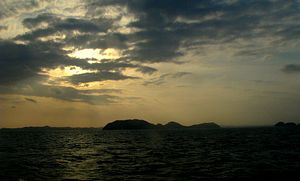As the week wraps up, here’s a curated collection of analysis and coverage of the South China Sea ruling this week–at The Diplomat and elsewhere–that’s worth reading to get a sense of the legal, strategic, and political complexities that lie ahead. We’ll have lots more here at The Diplomat in the coming weeks and months on the South China Sea, but the links below should provide a well-contoured understanding of the implications of Tuesday’s award.
First, if you missed the ruling, I’ve got a summary of its basic findings here. I also wrote a more detailed look at the ruling’s implications after partially reading through the award. Prashanth Parameswaran also has a look at the implications of the ruling here at Flashpoints. Meanwhile, Shannon Tiezzi takes a more in-depth look at the award’s findings on China’s damage to the environment in the South China Sea — the court ruled that Beijing had caused “irreparable” environmental damage. (Bonus: Victor Robert Lee’s satellite imagery analysis of ecological damage in the Spratlys from earlier this year in The Diplomat was cited by the arbitral tribunal.) The always-helpful folks at the Center for Strategic and International Studies’ Asia Maritime Transparency Initiative have mapped out the legal entitlements of Spratly features following the award.
How have states reacted to the ruling? I watched China’s actions in the first 36 hours after the ruling emerged, a critical time for Beijing to make its intentions known. All things considered, China’s reaction to the ruling could have been much more forceful. In the Nikkei Asian Review, Bill Hayton discusses possible reactions by regional states and China. Franz-Stefan Gady writes on a joint India-Japan statement on the dispute, calling on all parties to refrain from the use of force and resolve matters peacefully while respecting UNCLOS. Shannon, meanwhile, discusses Taiwan’s reaction to the ruling. (Taipei is particularly upset with the tribunal’s finding that Itu Aba, the largest Spratly feature and a Taiwanese possession, is not an island.) Shannon also writes on China’s initial rhetorical backlash against the award.
What should states do in the wake of the ruling? Dingding Chen, here in Flashpoints, cautions that the United States and China would do well to exercise calm and patience in the wake of the ruling. Prashanth urges the Association of Southeast Asian Nations to come together in the aftermath of the ruling and issue a statement on the award. Also here in The Diplomat, Mico A. Galang discusses the Philippines’ options for leveraging the ruling to its advantage. Harry Krejsa cautions the Duterte government against excessive concessions in the wake of the ruling. Gerrit van der Wees writes that the ruling, despite Taipei’s protests, is actually good for Taiwan. Over at Brookings, Jeffrey A. Bader outlines a road map for the United States and China in the aftermath of the ruling. In The Diplomat, Eric Huang discusses Taiwan’s continued adherence to the nine-dash line claim. Finally, in the Nikkei Asian Review, Bill Hayton discusses the importance of helping China find a workable “off ramp” after the award — a necessity for preventing tensions from escalating.
In the aftermath of the ruling, there have been several helpful looks at China’s view of the South China Sea disputes as well. Bill Hayton, in the National Interest, discusses why China’s reaction proves that these disputes were always emotional and not about history. Over at East Asia Forum, Andrew Chubb explores if Beijing clarified the nature of its nine-dash line claim by way of a subtle difference in a statement released after the ruling. M. Taylor Fravel, in the Washington Post, outlines the reasons China cares deeply about the South China Sea in a way that it hasn’t about its land border disputes. Zheng Wang, in The Diplomat, finally looks at the lessons China should draw from the result in the South China Sea case. Finally, Flynt Leverett takes a look at why China might actively revolt against the U.S.-led international order in the aftermath of this ruling.
Finally, if you prefer to absorb the implications of this ruling via audio, Prashanth and I talk over the ruling at length on the latest episode of the podcast here at The Diplomat, focusing on the likely next steps by various actors in the region. (I also recommend listening to the previous episode previewing the ruling where we discuss the case itself in more detail.)
(A bonus recommended read this weekend is the New York Times‘ profile of Paul S. Reichler, the Philippines’ top international lawyer in the case against China.)
































